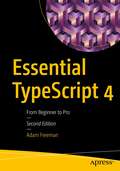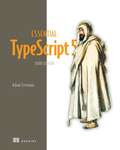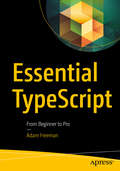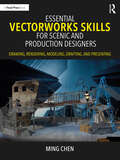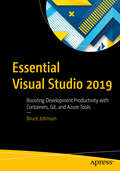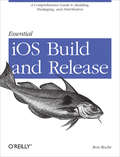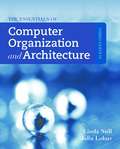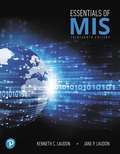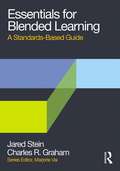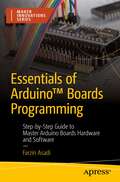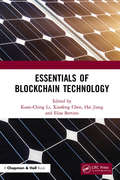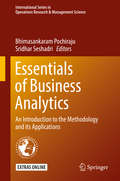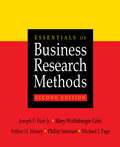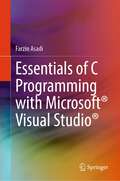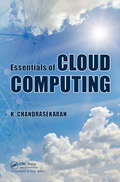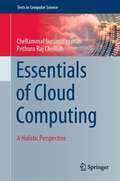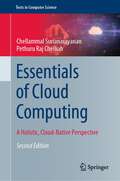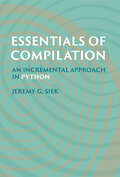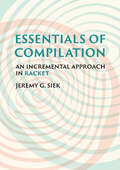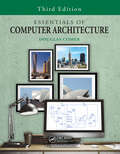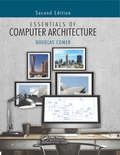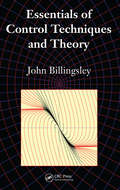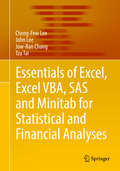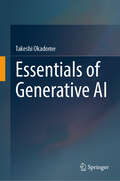- Table View
- List View
Essential TypeScript 4: From Beginner to Pro
by Adam FreemanLearn the essentials and more of TypeScript, a popular superset of the JavaScript language that adds support for static typing. TypeScript combines the typing features of C# or Java with the flexibility of JavaScript, reducing typing errors and providing an easier path to JavaScript development.Author Adam Freeman explains how to get the most from TypeScript 4 in this second edition of his best-selling book. He begins by describing the TypeScript language and the benefits it offers and then shows you how to use TypeScript in real-world scenarios, including development with the DOM API, and popular frameworks such as Angular and React. He starts from the nuts-and-bolts and builds up to the most advanced and sophisticated features.Each topic is covered clearly and concisely, and is packed with the details you need to be effective. The most important features are given a no-nonsense, in-depth treatment and chapters include common problems and teach you how to avoid them.What You Will LearnGain a solid understanding of the TypeScript language and toolsUse TypeScript for client- and server-side developmentExtend and customize TypeScriptTest your TypeScript codeApply TypeScript with the DOM API, Angular, React, and Vue.js Who This Book Is ForJavaScript developers who want to use TypeScript to create client-side or server-side applications
Essential TypeScript 5, Third Edition
by Adam FreemanNow in its third edition, this bestselling guide to TypeScript takes you through the nuts and bolts of the language. No frills, no fuss—just TypeScript essentials!TypeScript enhances JavaScript with static typing, while keeping all the JS flexibility you know and love! It&’s the perfect choice for any developer looking to improve the predictability and reliability of their code. Essential TypeScript 5, Third Edition teaches you how to get the most out of TypeScript 5 for a consistent, dependable development experience. Inside Essential TypeScript 5, Third Edition you&’ll learn how to: Configure the TypeScript development tools Use type annotations Create strongly typed functions and classes Use generic types Use type guards to determine types Create and consume type declaration files Use TypeScript to create web applications with Angular and React The book starts you off with a proper understanding of the JavaScript type system that will make using TypeScript so much easier. On that solid foundation, you&’ll build your understanding of TypeScript development, following a hands-on learning path all the way to TypeScript&’s advanced features. About the technology TypeScript is a popular superset of JavaScript that adds support for static typing. TypeScript&’s typing features, which will be instantly familiar to C# or Java programmers, help you reduce errors and improve the overall quality of your JavaScript code. About the book Essential TypeScript 5 is a fully updated third edition of the classic Adam Freeman bestseller. It provides full coverage of TypeScript 5, including new features like decorators. You&’ll begin with the hows-and-whys of TypeScript, then quickly progress to practical applications of static types. No wasted pages! Each chapter is focused on the skills you need to write awesome web apps. What's inside Configure your development tools Create strongly typed functions and classes Use generic types, type annotations, and type guards Create and consume type declaration files About the reader For JavaScript developers. No previous experience with TypeScript required. About the author Adam Freeman has held senior positions in a range of companies, most recently serving as CTO and COO of a global bank. He has written 50 programming books. The technical editor on this book is Fabio Claudio Ferracchiati. Table of Contents 1 Understanding TypeScript Part 1 2 Your first TypeScript application 3 JavaScript primer, part 1 4 JavaScript primer, part 2 5 Using the TypeScript compiler 6 Testing and debugging TypeScript Part 2 7 Understanding static types 8 Using functions 9 Using arrays, tuples, and enums 10 Working with objects 11 Working with classes and interfaces 12 Using generic types 13 Advanced generic types 14 Using decorators 15 Working with JavaScript Part 3 16 Creating a stand-alone web app, part 1 17 Creating a stand-alone web app, part 2 18 Creating an Angular app, part 1 19 Creating an Angular app, part 2 20 Creating a React app 21 Creating a React app, part 2
Essential TypeScript: From Beginner to Pro
by Adam FreemanWork with Typescript and get the most from this versatile open source language. Author Adam Freeman begins this book by describing Typescript and the benefits it offers, and goes on to show you how to use TypeScript in realistic scenarios, going in-depth to give you the knowledge you need. Starting from the nuts-and-bolts and building up to the most advanced and sophisticated features, you will learn how TypeScript builds on the JavaScript type system to create a safer and more productive development experience and understand how TypeScript can be used to create applications using popular frameworks, including Node.js, Angular, React, and Vue.js.Each topic is covered clearly and concisely and is packed with the details you need to learn to be truly effective. The most important features are given a no-nonsense in-depth treatment and chapters include common problems and details of how to avoid them.What You Will LearnGain a solid understanding of the TypeScript language and toolsUse TypeScript for client- and server-side developmentExtend and customize TypeScriptDebug and unit test your TypeScript codeWho This Book Is ForDevelopers who want to start using TypeScript, for example to create rich web applications using Angular, React, or Vue.jsAdam Freeman is an experienced IT professional who has held senior positions in a range of companies, most recently serving as chief technology officer and chief operating officer of a global bank. Now retired, he spends his time writing and long-distance running.
Essential Vectorworks Skills for Scenic and Production Designers: Drawing, Rendering, Modeling, Drafting, and Presenting
by Ming ChenEssential Vectorworks Skills for Scenic and Production Designers is an accessible textbook that covers the digital skills of 2D drawing, 3D modeling, rendering, drafting, and design presentation, providing aspiring designers with an invaluable toolkit to quickly and efficiently hone their craft.Modeled after learner-centered teaching practice and based on USITT drafting standards, this book is structured around six carefully selected core projects. It introduces key terms and commands, tools, techniques, and procedures for drawing, modeling, rendering, drafting, and design presentation with Vectorworks. Each chapter begins with key commands and a set of learning objectives that will be explored. The design exercises and projects that follow invite the reader’s active participation in the learning process. Along with step-by-step instructions, 240 illustrations (including student work samples), and three insightful interviews with professional designers, this book also contains open-ended projects that encourage the reader to explore new ways of scenographic expression and creatively apply commands and techniques to solve example design problems.This textbook is for use in scenic design, drafting, model making, and rendering courses in university theatre and media programs, and may be of interest to emerging professional scenic designers or scenographers for theatre, opera, and concert performances, production designers or art directors in film and television industries, themed exhibition designers, and theme park designers.Essential Vectorworks Skills for Scenic and Production Designers includes access to a wealth of online resources, including 15 videos with step-by-step instruction, six files of vwx or PDF formats for additional exercises and projects, and a video of student work samples.
Essential Visual Studio 2019: Boosting Development Productivity with Containers, Git, and Azure Tools
by Bruce JohnsonDiscover how Visual Studio 2019 can improve your development process. Visual Studio is an integral part of the daily life of millions of developers worldwide. Even as this rich integrated development environment approaches two decades, it has never ceased in innovating ways to make developers’ work life more productive. Essential Visual Studio 2019 offers explicit guidance for the developer who is already familiar with Visual Studio, but might feel a little lost when it comes to understanding the more recent features and advances of the IDE. Busy developers simply don’t have the time to digest and distill what the latest and greatest tools are with each version. As a result, useful process and performance features may be overlooked. This book, by simply focusing on the most recent innovations in Visual Studio and its tangential developer market, is the perfect "go to" for bridging that gap.Be ready to plunge headfirst into key features and advances that have been added, expanded, or improved, and topics such as unit testing, refactoring, Git, debugging, containers, and more. You will procure the basic concepts and value first, before diving into hands-on code that is designed to quickly get you up and running. The goal of this book is to bring the developer up to speed on Visual Studio 2019. It does not focus just on functionality added in Visual Studio 2019, but takes a deep dive into the areas where Visual Studio 2019 changed. That way, even if you’re coming from much earlier versions of Visual Studio, you can easily discern how upgrading to Visual Studio 2019 can make you more productive.What You Will Learn Know how the new features and improvements in Visual Studio 2019 can make you more productiveUnderstand the value of modifications and when they can be used to take full advantage of this powerful IDEReview changes to Visual Studio over the last two versions and see where the development process is headingDiscover the cloud-based, containerized, dev-ops-aware, and platform-flexible aspects of Visual StudioGain clarity on the areas that have the greatest impact to you personallyWho This Book Is ForDevelopers who use Visual Studio on a daily basis. Familiarity with earlier versions is helpful, as the book is not a soup-to-nuts survey of the IDE and some basic functions will not be covered.
Essential iOS Build and Release: A Comprehensive Guide to Building, Packaging, and Distribution (Oreilly And Associate Ser.)
by Ron RocheFrustrated by the requirements for testing and distributing your iOS app? You’re not alone. This concise book takes you step by step through the maze of certification and provisioning processes that have to happen before, during, and after development. You’ll learn what’s required to sign certificates, test your app on iOS devices, and release the finished product to the App Store.Whether you’re a developer looking to spend more time coding and less time figuring out how to install your application, or a release engineer responsible for producing reliable builds, this guide will help you successfully navigate the build and release processes for your iOS app.Get an overview of the iOS Dev Center, including the iOS Provisioning Portal, Member Center, and iTunes ConnectCreate your App ID, and generate signing certificates for development and distributionManage the provisioning profiles necessary to test your app on iOS devicesLearn common scenarios for iOS Simulator, Ad Hoc, and App Store distribution buildsAutomate the process to continuously build, sign, and package your app(s) for distribution
Essentials Of Computer Organization And Architecture
by Linda Null Julia LoburUpdated and revised with the latest data in the field, The Essentials of Computer Organization and Architecture, Third Edition is a comprehensive resource that addresses all of the necessary organization and architecture topics, yet is appropriate for the one-term course. This best-selling text correlates to the 2008 ACM-IEEE Computer Science Curriculum update and exposes readers to the inner workings of a modern digital computer through an integrated presentation of fundamental concepts and principles. The authors present real-world examples and focus on practical applications, thus encouraging students to develop a "big picture" understanding of how essential organization and architecture concepts are applied in the world of computing.
Essentials Of Mis, Student Value Edition
by Kenneth C. Laudon Jane LaudonEssentials of MIS is an in-depth look at how today's businesses use information technologies and systems to achieve their corporate objectives. Current real-world business cases illustrate how companies have identified, and ultimately solved, key business challenges using information systems and technologies. Through the use of Essentials of MIS, you will be able to participate in, and even lead, management discussions of information systems for a firm. <P><P> The 13th Edition consists of 12 chapters with hands-on projects that cover the most essential topics in MIS. In addition to the core text, this edition includes a Video Case Package consisting of 28 video case studies and 10 instructional videos to illustrate business uses of information systems, explain new technologies, and explore concepts. The knowledge and information in this book will be most valuable throughout your business career.
Essentials for Blended Learning: A Standards-Based Guide (Essentials of Online Learning)
by Charles R. Graham Jared SteinEssentials for Blended Learning: A Standards-Based Guide provides a practical, streamlined approach for creating effective learning experiences by blending online activities and the best of face-to-face teaching. This guide is: Easy to use: Clear, jargon-free writing; illustrations; and references to online resources help readers understand concepts. Streamlined: A simple but effective design process focuses on creating manageable activities for the right environment. Practical: Real-world examples from different subject areas help teachers understand principles in context. Contemporary: The variety of modern, connected technologies covered in the guide addresses a range of teaching challenges. Forward-Looking: The approach bridges the gap between formal classroom learning and informal lifelong learning. Standards-based: Guidelines and standards are based on current research in the field, relevant learning theories, and practitioner experiences. Effective blended learning requires significant rethinking of teaching practices and a fundamental redesign of course structure. Essentials for Blended Learning: A Standards-Based Guide simplifies these difficult challenges without neglecting important opportunities to transform teaching. This guide is suitable for teachers in any content area. Please visit www.essentialsforblended.com for additional resources.
Essentials of Arduino™ Boards Programming: Step-by-Step Guide to Master Arduino Boards Hardware and Software (Maker Innovations Series)
by Farzin AsadiLearn to use the Arduino boards to do big jobs in a simple way. This book is full of real-world examples for Arduino enthusiasts of all experience levels. All of the examples in this book use Arduino UNO, which is an excellent option for educational purposes. You'll start with an introduction to Arduino and see firsthand how its free multi-platform integrated development environment (IDE) makes coding easier. In many cases, you can edit the given codes to solve your own problems. Arduino boards use a variety of microcontrollers and each board is suitable for a specific application. The Arduino IDE is also preloaded with a broad library of codes that you can modify and practice with. So instead of coding from scratch you can adjust the codes for similar projects. More experienced users will save time by simply copying nuggets of code from the various libraries.You'll also learn about digital input/output (I/O), analog-to-digital and digital-to-analog converters, LCDs and EEPROM. The book then moves on to serial communication, mathematical functions, and pulse width modulation (PWM), all important features when encoding in telecommunications. Finally, you'll see how to control different types of motors, review interrupts, internal comparators, and timers, and read different sensors with Arduino.What You Will LearnTurn on/off a device using a relayGenerate analog/digital outputRead an analog/digital inputControl motors with a parallel virtual machine (PVM) and serial communicationDisplay text with LCDsRead sensors with Arduino and use the interruptsWrite more efficient codes with interrupts and timersWho This Book Is ForEngineering (electrical/computer/biomedical/robotic/mechatronics/aerospace) and science (math/physic/chemistry) students, makers, and hobbyists. Being familiar with a programming language (especially C) is an advantage, however, it is not necessary.
Essentials of Blockchain Technology
by Hai Jiang Elisa Bertino Kuan-Ching Li Xiaofeng ChenBlockchain technologies, as an emerging distributed architecture and computing paradigm, have accelerated the development/application of the Cloud/GPU/Edge Computing, Artificial Intelligence, cyber physical systems, social networking, crowdsourcing and crowdsensing, 5G, trust management, and finance. The popularity and rapid development of Blockchain brings many technical and regulatory challenges for research and academic communities. This book will feature contributions from experts on topics related to performance, benchmarking, durability, robustness, as well data gathering and management, algorithms, analytics techniques for transactions processing, and implementation of applications.
Essentials of Business Analytics: An Introduction to the Methodology and its Applications (International Series in Operations Research & Management Science #264)
by Bhimasankaram Pochiraju Sridhar SeshadriThis comprehensive edited volume is the first of its kind, designed to serve as a textbook for long-duration business analytics programs. It can also be used as a guide to the field by practitioners. The book has contributions from experts in top universities and industry. The editors have taken extreme care to ensure continuity across the chapters.The material is organized into three parts: A) Tools, B) Models and C) Applications. In Part A, the tools used by business analysts are described in detail. In Part B, these tools are applied to construct models used to solve business problems. Part C contains detailed applications in various functional areas of business and several case studies. Supporting material can be found in the appendices that develop the pre-requisites for the main text. Every chapter has a business orientation. Typically, each chapter begins with the description of business problems that are transformed into data questions; and methodology is developed to solve these questions. Data analysis is conducted using widely used software, the output and results are clearly explained at each stage of development. These are finally transformed into a business solution. The companion website provides examples, data sets and sample code for each chapter.
Essentials of Business Research Methods: Third Edition
by Phillip Samouel Joseph F. Hair, Jr Mary Wolfinbarger Arthur H Money Michael J PageManagers increasingly must make decisions based on almost unlimited information. How can they navigate and organize this vast amount of data? Essentials of Business Research Methods provides research techniques for people who aren't data analysts. The authors offer a straightforward, hands-on approach to the vital managerial process of gathering and using data to make clear business decisions. They include such critical topics as the increasing role of online research, ethical issues, data mining, customer relationship management, and how to conduct information-gathering activities more effectively in a rapidly changing business environment. This is the only such book that includes a chapter on qualitative data analysis, and the coverage of quantitative data analysis is more extensive and much easier to understand than in other works. The book features a realistic continuing case throughout the text that enables students to see how business research information is used in the real world. It includes applied research examples in all chapters, as well as Ethical Dilemma mini - cases, and interactive Internet applications and exercises.
Essentials of C Programming with Microsoft® Visual Studio®
by Farzin AsadiThis book provides a compact but comprehensive treatment that guides readers through the C programming language with Microsoft® Visual Studio®. The author uses his extensive classroom experience to guide readers toward deeper understanding of key concepts of the C language. Each concept and feature of the language is presented as a short lesson, illustrated by practical worked examples to aid student self study. The book will appeal to a broad range of students who are required to study the C programming language.
Essentials of Cloud Computing
by K. ChandrasekaranCloud computing-accessing computing resources over the Internet-is rapidly changing the landscape of information technology. Its primary benefits compared to on-premise computing models are reduced costs and increased agility and scalability. Hence, cloud computing is receiving considerable interest among several stakeholders-businesses, the IT ind
Essentials of Cloud Computing: A Holistic Perspective (Texts in Computer Science)
by Pethuru Raj Chelliah Chellammal SurianarayananThis reader-friendly textbook presents a comprehensive overview of the essential aspects of cloud computing, from the origin of the field to the latest developments. Rather than merely discussing the cloud paradigm in isolation, the text also examines how cloud computing can work collaboratively with other computing models to meet the needs of evolving computing trends. This multi-dimensional approach encompasses the challenges of fulfilling the storage requirements of big data, the use of the cloud as a remote server for Internet of Things and sensor networks, and an investigation of how cloud computing is interlinked with edge, fog and mist computing, among other illuminating perspectives.Topics and features: includes learning objectives, motivating questions, and self-test exercises in every chapter; presents an introduction to the underlying concepts, fundamental features, and key technological foundations of cloud computing; examines how enterprise networking and cloud networking can work together to achieve business goals; reviews the different types of cloud storage available to address the evolution of data and the need for digitization; discusses the challenges and approaches to implementing cloud security, and the hot topic of cloud management; highlights the value of cloud brokerage capabilities, and explains the importance of cloud orchestration in multi-cloud environments; describes the details of cloud migration, the crucial role of monitoring in optimizing the cloud, and the basics of disaster recovery using cloud infrastructure.This technically rigorous yet simple-to-follow textbook is an ideal resource for graduate courses on cloud computing. Professional software developers and cloud architects will also find the work to be an invaluable reference.
Essentials of Cloud Computing: A Holistic, Cloud-Native Perspective (Texts in Computer Science)
by Pethuru Raj Chelliah Chellammal SurianarayananNumerous advancements are being brought in and incorporated into the cloud domain with the aim of realizing a trove of deeper and decisive automations.Rather than discussing the cloud paradigm in isolation, this fully updated text examines how cloud computing can work collaboratively with other computing models to meet the needs of evolving trends.This multi-dimensional approach encompasses the challenges of fulfilling the storage requirements of big data, the use of the cloud as a remote server for Internet of Things and sensor networks, and an investigation of how cloud computing is interlinked with other established computing phenomenon such as edge computing. New chapters illustrate the distinct ideals of the cloud-native computing, proclaimed as the next-generation cloud computing paradigm.Topics and features:Includes learning objectives, motivating questions, and self-test exercisesIntroduces the underlying concepts, fundamental features, and key technological foundations of cloud computingExamines how enterprise networking and cloud networking can work together to achieve business goalsReviews the different types of cloud storage available to address the evolution of data and the need for digitizationDiscusses the challenges and approaches to implementing cloud governance, security, and the hot topic of cloud managementDescribes the details of cloud migration, the crucial role of monitoring in optimizing the cloud, and the basics of disaster recovery using cloud infrastructureThis technically rigorous, yet simple-to-follow textbook is an ideal resource for graduate courses on cloud computing. Professional software developers and cloud architects will also find the work to be an invaluable reference.
Essentials of Compilation: An Incremental Approach in Python
by Jeremy G. SiekA hands-on approach to understanding and building compilers using the programming language Python.Compilers are notoriously difficult programs to teach and understand. Most books about compilers dedicate one chapter to each progressive stage, a structure that hides how language features motivate design choices. By contrast, this innovative textbook provides an incremental approach that allows students to write every single line of code themselves. Jeremy Siek guides the reader in constructing their own compiler in the powerful object-oriented programming language Python, adding complex language features as the book progresses. Essentials of Compilation explains the essential concepts, algorithms, and data structures that underlie modern compilers and lays the groundwork for future study of advanced topics. Already in wide use by students and professionals alike, this rigorous but accessible book invites readers to learn by doing. Deconstructs the challenge of compiler construction into bite-sized piecesEnhances learning by connecting language features to compiler design choicesDevelops understanding of how programs are mapped onto computer hardwareClassroom-tested, hands-on approach suitable for students and professionalsExtensive ancillary resources include source code and solutions
Essentials of Compilation: An Incremental Approach in Racket
by Jeremy G. SiekA hands-on approach to understanding and building compilers.Compilers are notoriously some of the most difficult programs to teach and understand. Most books about compilers dedicate one chapter to each progressive stage, a structure that hides how language features motivate design choices. By contrast, this innovative textbook provides an incremental approach that allows students to write every single line of code themselves. Essentials of Compilation guides the reader in constructing their own compiler for a small but powerful programming language, adding complex language features as the book progresses. Jeremy Siek explains the essential concepts, algorithms, and data structures that underlie modern compilers and lays the groundwork for future study of advanced topics. Already in wide use by students and professionals alike, this rigorous but accessible book invites readers to learn by doing. Deconstructs the challenge of compiler construction into bite-sized piecesEnhances learning by connecting language features to compiler design choicesDevelops understanding of how programs are mapped onto computer hardwareLearn-by-doing approach suitable for students and professionalsProven in the classroomExtensive ancillary resources include source code and solutions
Essentials of Computer Architecture
by Douglas ComerThis easy-to-read textbook provides an introduction to computer architecture, focusing on the essential aspects of hardware that programmers need to know. Written from a programmer’s point of view, Essentials of Computer Architecture, Third Edition, covers the three key aspects of architecture: processors, physical and virtual memories, and input-output (I/O) systems.This third edition is updated in view of advances in the field. Most students only have experience with high-level programming languages, and almost no experience tinkering with electronics and hardware. As such, this text is revised to follow a top-down approach, moving from discussions on how a compiler transforms a source program into binary code and data, to explanations of how a computer represents data and code in binary.Additional chapters cover parallelism and data pipelining, assessing the performance of computer systems, and the important topic of power and energy consumption. Exclusive to this third edition, a new chapter explains multicore processors and how coherence hardware provides a consistent view of the values in memory even though each core has its own cache.Suitable for a one-semester undergraduate course, this clear, concise, and easy-to-read textbook offers an ideal introduction to computer architecture for students studying computer programming.
Essentials of Computer Architecture (Second Edition)
by Douglas ComerThis easy to read textbook provides an introduction to computer architecture, while focusing on the essential aspects of hardware that programmers need to know. The topics are explained from a programmer’s point of view, and the text emphasizes consequences for programmers. Divided in five parts, the book covers the basics of digital logic, gates, and data paths, as well as the three primary aspects of architecture: processors, memories, and I/O systems. The book also covers advanced topics of parallelism, pipelining, power and energy, and performance. A hands-on lab is also included. The second edition contains three new chapters as well as changes and updates throughout.
Essentials of Control Techniques and Theory
by John BillingsleyCarefully separating the essential from the ornamental, Essentials of Control Techniques and Theory presents the nuts and bolts for designing a successful controller. It discusses the theory required to support the art of designing a working controller as well as the various aspects to convince a client, employer, or examiner of your expertise.A Compelling Account of the Basics of Control TheoryControl solutions for practicing engineersUsing the author’s own Javascript On-Line Learning Interactive Environment for Simulation (Jollies), the text relies on computer-based graphical analysis methods, such as Nyquist, Nichols, root locus, and phase-plane, to illustrate how useful computer simulation can be for analyzing both linear and nonlinear systems. It explains step-by-step the design and modeling of various control systems, including discrete time systems and an inverted pendulum. Along with offering many web-based simulations, the book shows how mathematics, such as vectors, matrices, and the differential equations that govern state variables, can help us understand the concepts that underpin the controller’s effects. From frequency domain analysis to time-domain state-space representation, this book covers many aspects of classical and modern control theory. It presents important methods for designing and analyzing linear systems and controllers.
Essentials of Dynamics and Vibrations
by John BillingsleyThis updated second edition brings the complex mathematics of three-dimensional dynamics to life with real-time simulations, making the equations easier to grasp. Covering core topics in mechanical engineering such as kinematics, dynamics, vibration analysis, gyroscopes, gears, and Euler’s equations, the book offers a clear and engaging approach for students, professionals, and enthusiasts alike. With a focus on practical applications, it explains everything from the laws of motion to motors and mechanisms, providing a comprehensive understanding of mechanical systems. New to this edition is a chapter on Power, Energy, and Perpetual Motion, which reveals intriguing comparisons, such as the energy needed to lift water versus the heat required to warm it. The final chapter, Rocket Science, has been expanded to debunk myths about black holes and gravity, humorously addressing science fiction misconceptions while proposing exciting space projects.
Essentials of Excel, Excel VBA, SAS and Minitab for Statistical and Financial Analyses
by John Lee Cheng-Few Lee Jow-Ran Chang Tzu TaiThis introductory textbook for business statistics teaches statistical analysis and research methods via business case studies and financial data using Excel, MINITAB, and SAS. Every chapter in this textbook engages the reader with data of individual stock, stock indices, options, and futures. One studies and uses statistics to learn how to study, analyze, and understand a data set of particular interest. Some of the more popular statistical programs that have been developed to use statistical and computational methods to analyze data sets are SAS, SPSS, and MINITAB. Of those, we look at MINITAB and SAS in this textbook. One of the main reasons to use MINITAB is that it is the easiest to use among the popular statistical programs. We look at SAS because it is the leading statistical package used in industry. We also utilize the much less costly and ubiquitous Microsoft Excel to do statistical analysis, as the benefits of Excel have become widely recognized in the academic world and its analytical capabilities extend to about 90 percent of statistical analysis done in the business world. We demonstrate much of our statistical analysis using Excel and double check the analysis and outcomes using MINITAB and SAS - also helpful in some analytical methods not possible or practical to do in Excel.
Essentials of Generative AI
by Takeshi OkadomeThis book provides a concise yet comprehensive introduction to generative artificial intelligence. The first part explains the foundational technologies and architectures that support the realization of generative models. It covers evolved and deepened elements, word embeddings as a representative example of representation learning, and the Transformer as a network foundation, along with its underlying attention mechanism. Reinforcement learning, which became essential for elevating large-scale language models to language generation models, is also discussed in detail, focusing on essential aspects. The second part deals with language generation. It starts by elucidating language models and introduces large-scale language models with broad applications as the foundational architecture of language processing, further discussing language generation models as their evolution. Though not common terminology, in this book, models such as ChatGPT and Llama 2, which are large-scale language models fine-tuned using reinforcement learning, are referred to as generative language models. The third part addresses image generation, discussing variational autoencoders and the remarkable diffusion models. Additionally, it explains Generative Adversarial Networks(GAN). Although GAN poses challenges due to unstable learning, their conceptual framework is widely applicable, especially Wasserstein GAN seems suitable for introducing optimal trans- port distance, which is utilized in various scenarios. This book primarily serves as a companion for researchers or graduate students in machine learning, aiming to help them understand the essence of generative AI and lay the groundwork for advancing their own research.
